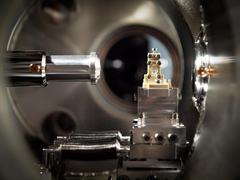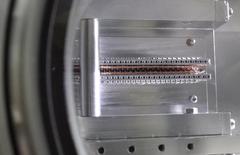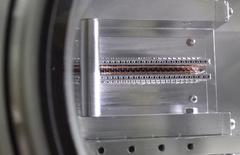URL: https://www.desy.de/news/news_search/index_eng.html
Breadcrumb Navigation
DESY News: Plasma accelerator produces first X-rays
News
News from the DESY research centre
Plasma accelerator produces first X-rays
For the first time, a plasma accelerator at DESY has produced X-rays. The LUX installation, which is headed by Andreas Maier of the University of Hamburg, created ultra-short pulses of radiation with a wavelength of nine nanometres (millionths of a millimetre), corresponding to so-called soft X-rays. “This is an important milestone in the development of novel, accelerator-driven X-ray sources,” as the head of the accelerator physics at the University of Hamburg, Florian Grüner, points out. LUX (Latin for “light”) is part of the LAOLA collaboration between DESY and the university. "I am very pleased that another important success could be achieved in these novel accelerator research activities, set up a couple of years ago," says the director of the DESY Accelerator Division, Reinhard Brinkmann. "The development of the next generation of compact accelerators is an essential pillar of our strategy for the future at the research campus."

The plasma cell (centre) accelerates the electrons. Credit: Niels Delbos, Universität Hamburg
“LUX uses a laser with a power of 200 trillion watts, which fires ultra-short pulses into hydrogen gas,” says Maier. “Electrons collect in the wake of each pulse, which are then accelerated by the positively charged plasma wave in front of them – much like a wakesurfer rides a boat’s wake.”
As a result, the electrons accumulate up to 600 million electron-volts (600 MeV) of energy within a distance of just a few millimetres, the length of the plasma cell in the LUX accelerator. This is more energy than is supplied by the 70 metre long linear pre-accelerator LINAC II at DESY.
The team headed by Maier, who was instrumental in developing and setting up the facility, has now for the first time used the high-speed electrons from its plasma cell to produce X-rays. It achieved this by sending the short bunches of electrons down a 50 centimetre long, undulating magnetic path, in which an extremely strong magnetic field switches direction every 2.5 millimetres. Following this zig-zag path through the so-called undulator causes the electrons to release energy in the form of X-rays.
This is the same principle used by the large X-ray sources at DESY, such as the storage ring PETRA III or the X-ray free-electron laser European XFEL. LUX has now generated the first X-rays from a plasma accelerator on the DESY campus. “Even worldwide, only a handful of research groups have managed to do this so far,” emphasises Maier. “A crucial contribution to our success was the fantastic support we received from the technical groups involved.”

The undulator is the magnetic slalom track of LUX where the fast electrons emit X-ray light. Credit: Maximilian Trunk, Universität Hamburg
On top of this, the underlying principle behind the technique means that the X-ray pulse and the pulse of optical laser light that creates the plasma wave are extremely precisely synchronised. Many experiments use an optical laser pulse to trigger a reaction, whose progress is then studied by scrutinising it using very precisely delayed X-ray pulses. Maier reports that LUX will be able to achieve synchronisations between the X-ray and the optical pulse to within a single femtosecond.
The next thing the physicists want to do is to further optimise their plasma accelerator and their undulator, so as to produce higher-energy electrons and brighter X-rays with a shorter wavelength. In the end, the scientists hope to improve their set-up to a point where they reach a self-amplifying laser process. This would turn the machine into a compact X-ray laser. “That is our definite goal; but the route we must follow to get there will be challenging,” Maier emphasises. “A project like this can only succeed through the close collaboration of its two partners, the university and DESY.”
A number of different groups at the University of Hamburg and at DESY are collaborating at LAOLA, with a view to exploring pioneering new concepts for accelerators. The collaboration between the two institutions was launched back in 2011 by Grüner and Brinkmann. Another important partner in the collaboration is the ELI Beamlines Project in Prague (Czech Republic), that supported the project with additional manpower and resources. “Teaming with our German partners we are following a straight line to extend LUX to a compact laser driven free-electron laser which would open new scientific and technological possibilities,“ says the scientific director of ELI Beamlines, Georg Korn.
The idea of plasma acceleration is being studied at DESY by various projects which are pursuing different goals.
LUX-Homepage: http://lux.cfel.de




